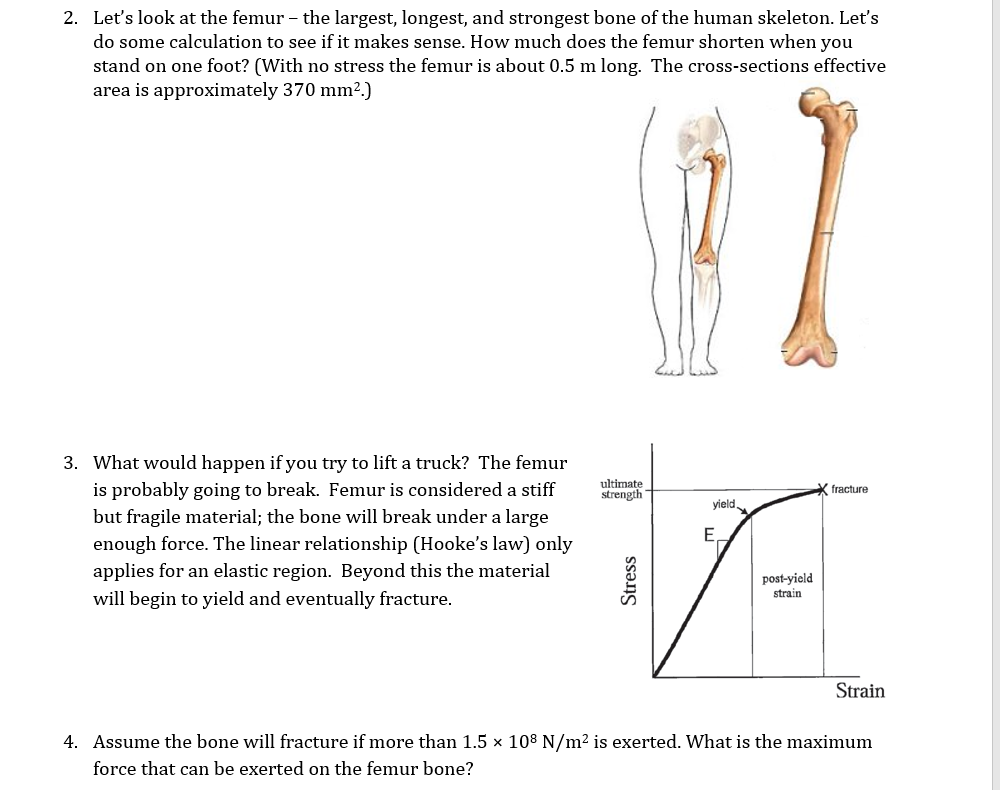2. Let's look at the femur – the largest, longest, and strongest bone of the human skeleton. Let's do some calculation to see if it makes sense. How much does the femur shorten when you stand on one foot? (With no stress the femur is about 0.5 m long. The cross-sections effective area is approximately 370 mm2.) would happen if you try to lift a truck? The femur is probably going to break. Femur is considered a stiff 3. ultimate strength X fracture yield but fragile material; the bone will break under a large E enough force. The linear relationship (Hooke's law) only applies for an elastic region. Beyond this the material post-yield strain will begin to yield and eventually fracture. Strain 4. Assume the bone will fracture if more than 1.5 x 108 N/m2 is exerted. What is the maximum force that can be exerted on the femur bone? Stress
2. Let's look at the femur – the largest, longest, and strongest bone of the human skeleton. Let's do some calculation to see if it makes sense. How much does the femur shorten when you stand on one foot? (With no stress the femur is about 0.5 m long. The cross-sections effective area is approximately 370 mm2.) would happen if you try to lift a truck? The femur is probably going to break. Femur is considered a stiff 3. ultimate strength X fracture yield but fragile material; the bone will break under a large E enough force. The linear relationship (Hooke's law) only applies for an elastic region. Beyond this the material post-yield strain will begin to yield and eventually fracture. Strain 4. Assume the bone will fracture if more than 1.5 x 108 N/m2 is exerted. What is the maximum force that can be exerted on the femur bone? Stress
College Physics
11th Edition
ISBN:9781305952300
Author:Raymond A. Serway, Chris Vuille
Publisher:Raymond A. Serway, Chris Vuille
Chapter9: Fluids And Solids
Section: Chapter Questions
Problem 73P: A high-speed lifting mechanism supports an 800.-kg object with a steel cable that is 25.0 m long and...
Related questions
Question

Transcribed Image Text:2. Let's look at the femur – the largest, longest, and strongest bone of the human skeleton. Let's
do some calculation to see if it makes sense. How much does the femur shorten when you
stand on one foot? (With no stress the femur is about 0.5 m long. The cross-sections effective
area is approximately 370 mm2.)
would happen if you try to lift a truck? The femur
is probably going to break. Femur is considered a stiff
3.
ultimate
strength
X fracture
yield
but fragile material; the bone will break under a large
E
enough force. The linear relationship (Hooke's law) only
applies for an elastic region. Beyond this the material
post-yield
strain
will begin to yield and eventually fracture.
Strain
4. Assume the bone will fracture if more than 1.5 x 108 N/m2 is exerted. What is the maximum
force that can be exerted on the femur bone?
Stress
Expert Solution
This question has been solved!
Explore an expertly crafted, step-by-step solution for a thorough understanding of key concepts.
This is a popular solution!
Trending now
This is a popular solution!
Step by step
Solved in 2 steps with 2 images

Knowledge Booster
Learn more about
Need a deep-dive on the concept behind this application? Look no further. Learn more about this topic, physics and related others by exploring similar questions and additional content below.Recommended textbooks for you

College Physics
Physics
ISBN:
9781305952300
Author:
Raymond A. Serway, Chris Vuille
Publisher:
Cengage Learning

College Physics
Physics
ISBN:
9781285737027
Author:
Raymond A. Serway, Chris Vuille
Publisher:
Cengage Learning

Physics for Scientists and Engineers, Technology …
Physics
ISBN:
9781305116399
Author:
Raymond A. Serway, John W. Jewett
Publisher:
Cengage Learning

College Physics
Physics
ISBN:
9781305952300
Author:
Raymond A. Serway, Chris Vuille
Publisher:
Cengage Learning

College Physics
Physics
ISBN:
9781285737027
Author:
Raymond A. Serway, Chris Vuille
Publisher:
Cengage Learning

Physics for Scientists and Engineers, Technology …
Physics
ISBN:
9781305116399
Author:
Raymond A. Serway, John W. Jewett
Publisher:
Cengage Learning

Physics for Scientists and Engineers: Foundations…
Physics
ISBN:
9781133939146
Author:
Katz, Debora M.
Publisher:
Cengage Learning

College Physics
Physics
ISBN:
9781938168000
Author:
Paul Peter Urone, Roger Hinrichs
Publisher:
OpenStax College

Physics for Scientists and Engineers
Physics
ISBN:
9781337553278
Author:
Raymond A. Serway, John W. Jewett
Publisher:
Cengage Learning